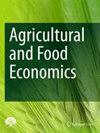儿童对红绿灯营养标签的偏好
IF 4.5
2区 经济学
Q1 AGRICULTURAL ECONOMICS & POLICY
引用次数: 0
摘要
摘要目的研究交通灯营养标签属性对儿童食品选择的影响。数据收集自对厄瓜多尔南部地区三个主要城市(马查拉、洛哈和萨莫拉)1179名公立初中和高中学生的调查。调查工具包括两组选择实验:一组是酸奶产品,另一组是软饮料(苏打水和果汁)。在选择场景中,孩子们被展示了两种价格不同的产品,糖、盐和脂肪的TL标签颜色也不同。采用混合logit模型对儿童在选择实验中的产品选择进行分析。结果表明,标签会影响食物的选择。此外,与带有红色标签的产品相比,儿童愿意为带有黄色、绿色和“不含”标签的产品支付更高的价格。总的来说,这项研究的发现提供了证据,证明TL标签在帮助儿童做出符合他们偏好的食品选择方面是有效的,因为TL标签代表着更健康的替代品。本文章由计算机程序翻译,如有差异,请以英文原文为准。
Traffic light nutrition labeling preferences among children
Abstract Objective This study evaluates the effects of traffic light (TL) nutritional label attributes on children’s food choices. Data were collected from a survey of 1179 Ecuadorian students attending public middle and high school in three major cities in the country’s southern region (Machala, Loja, and Zamora). The survey instrument included two sets of choice experiments: one with yogurt products and the other with soft drinks (sodas and juices). In the choice scenarios, children were presented with two products that differed in price and the TL label colors for sugar, salt, and fat. Children’s product selections in the choice experiments were analyzed using mixed logit models. The results indicate that labels affect food choices. Additionally, children are willing to pay increasing premium levels for products with yellow, green, and “does not contain” labels compared to products with red labels. Overall, the study’s findings offer evidence that TL labels are effective in helping children make food choices consistent with their preferences for food products with TL labels representing healthier alternatives.
求助全文
通过发布文献求助,成功后即可免费获取论文全文。
去求助
来源期刊

Agricultural and Food Economics
Agricultural and Biological Sciences-Agricultural and Biological Sciences (miscellaneous)
CiteScore
5.50
自引率
5.10%
发文量
29
审稿时长
13 weeks
期刊介绍:
Agricultural and Food Economics (AFE) is an international peer-reviewed and open access journal published on behalf of the Italian Society of Agricultural Economics. AFE welcomes research articles from economists, scholars and researchers from all over the world to publish problem-oriented and high-quality articles. AFE publishes only original articles from a wide variety of economic perspectives that address current and relevant issues related to the agricultural and food system. AFE publishes articles focused on applied analysis, the discussion of innovative results, and relevant policy and managerial implications. AFE seeks clearly written articles from experts in the field, to promote insightful understanding of the current trends in the agri-food system. Topics of specific interest to AFE include agricultural and food market analysis, agri-food firm management and marketing, organization of the agri-food chains, consumer behavior, food quality and safety issues, economics of nutrition and food security, food and health economics, agri-food policy and trade, sustainable rural development, natural and marine resource economics and land economics.
 求助内容:
求助内容: 应助结果提醒方式:
应助结果提醒方式:


